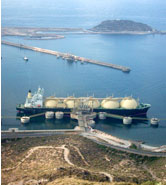China has maintained a level of growth based on natural gas consumption, and forecasts predict this trend to continue. It plans to construct new terminals (in the provinces of Shandong and Guangdong, for example) and is developing ambitious initiatives to localise and mine reserves in the country’s westernmost territory and offshore.
PetroChina estimates that the country’s overall demand for natural gas will reach 300 bcm in 2020. AIE forecasts (World Energy Outlook 2010) provide a more modest figure: 200 bcm.
Construction on the second line of the natural gas pipeline that will transport gas from Turkmenistan to China has begun. It will be finished in late 2011. Let us recall that the first line was completed in December 2009.
This Asian country features three operational terminals. In mid April, the construction of a fourth in the city of Zhuhai, in southern China, was approved. It will have a capacity of 3.5 million tonnes/year.
The Wood Mackenzie consulting firm sustains that, over the course of this decade, LNG imports will increase faster than those arriving via pipeline, coming to represent 20% of the total natural gas demand. After 2020, domestic production and pipeline imports will record greater share increases.
India’s gas market is also currently undergoing a significant growth process. Today, it plays home to two terminals (in Dahej and Hazira), with a joint capacity of 7 million tonnes/year, with a third (Ratnagiri) that may very well be operational by the time this Report is published. Forecasts predict that its capacity will reach 20 million tonnes/year during 2012. One of the government’s goals is to broaden the transmission network, which remains modest (around 11,000km), by adding another 7,500km in the near future.
Australia ranks fourth in the Asia-Oceania region in terms of natural gas production. Its projected exports are ambitious, despite delays in certain projects (the Gladstone LNG and the Australia Pacific LNG projects, for example), as the crisis has halted foreign demand. All this notwithstanding, and despite a sharp drop in projected imports within the US market, it maintains ambitious medium-term production and export plans.
Other countries in which the gas industry is expected to undergo development include, for example, Malaysia, Papua-New Guinea, Singapore and the Philippines. All four have developed projects to construct gas liquefaction plants. The first has evidenced the greatest amount of progress, with the Malacca terminal expected to be finished in 2012. Papua-New Guinea’s LNG terminal project has been on the table for the past several years, awaiting that final investment decision.

-
 SHELL
SHELL

